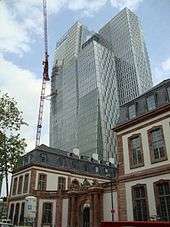Palais Thurn und Taxis

The Palais Thurn und Taxis (German: [paˈleː ˈtuːɐ̯n ʊnt ˈtaksɪs]) in Frankfurt, Germany was built from 1731 to 1739 by Robert de Cotte commissioned by the Prince Reichserbgeneralpostmeisters (English: Imperial Hereditary General Postmaster) Anselm Franz von Thurn und Taxis (1714–1739).
History
The palace has a very checkered history: 1748 it was the seat of the Imperial Headquarters of Thurn and Taxis post, from 1805 to 1813 the residence of the Prince Primate and the Grand Duke of Frankfurt, Karl Theodor von Dalberg. After the restoration of the Free City of Frankfurt here was held the Bundestag from 1816 to 1866, the Federal Assembly of the German Confederation.
In 1895 Prince Albert I von Thurn und Taxis sold the Palais to the Imperial Post, after he had to spend the interior in his St. Emmeram Castle in Regensburg, where it is today. In 1905 the city of Frankfurt took over the palace and sent to one in 1908 the Museum of Ethnology for the collections of the African explorer Leo Frobenius.
Demolition & reconstruction

During 1943 and 1944 the palace was badly damaged in several bombing of Frankfurt am Main in World War II and a good part of the substance, however, was preserved, for example, remains of ceiling paintings and stucco. Although a reconstruction would have been possible, the building was demolished in 1951, including the Portalbauten for construction of a telecommunications tower block. The Portalbauten were then rebuilt during the construction of telecommunications including high-rise building with modern reinforced concrete, but without using the previously backed mansard sandstone parts.
From 2004 to 2010 the palais has been reconstructed as part of the Palais Quartier development.
See also
| Wikimedia Commons has media related to Palais Thurn und Taxis. |
Coordinates: 50°06′54″N 8°40′47″E / 50.115°N 8.67972°E